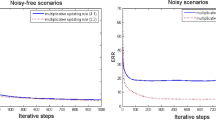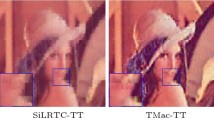Abstract
Nonnegative tensor factorization (NTF) has been widely applied in high-dimensional nonnegative tensor data analysis. However, existing algorithms suffer from slow convergence caused by the nonnegativity constraint and hence their practical applications are severely limited. By combining accelerated proximal gradient and low-rank approximation, we propose a new NTF algorithm which is significantly faster than state-of-the-art NTF algorithms.
Access this chapter
Tax calculation will be finalised at checkout
Purchases are for personal use only
Preview
Unable to display preview. Download preview PDF.
Similar content being viewed by others
References
Andersson, C.A., Bro, R.: The \(N\)-way toolbox for MATLAB (2000)
Bader, B.W., Kolda, T.G.: MATLAB tensor toolbox version 2.5 (February 2012)
Carroll, J., Chang, J.-J.: Analysis of individual differences in multidimensional scaling via an n-way generalization of Eckart-Young decomposition. Psychometrika 35(3), 283–319 (1970)
Cichocki, A., Zdunek, R., Phan, A.-H., Amari, S.: Nonnegative Matrix and Tensor Factorizations: Applications to Exploratory Multi-way Data Analysis and Blind Source Separation. Wiley, Chichester (2009)
Guan, N., Tao, D., Luo, Z., Yuan, B.: NeNMF: An optimal gradient method for nonnegative matrix factorization. IEEE Transactions on Signal Processing 60(6), 2882–2898 (2012)
Harshman, R.A.: Foundations of the PARAFAC procedure: Models and conditions for an ‘explanatory’ multi-modal factor analysis. UCLA Working Papers in Phonetics 16(1) (1970)
Kolda, T.G., Bader, B.W.: Tensor decompositions and applications. SIAM Review 51(3), 455–500 (2009)
Kruskal, J.B.: Three-way arrays: rank and uniqueness of trilinear decompositions, with application to arithmetic complexity and statistics. Linear Algebra and its Applications 18(2), 95–138 (1977)
Lee, D.D., Sebastian Seung, H.: Algorithms for non-negative matrix factorization. In: Leen, T.K., Dietterich, T.G., Tresp, V. (eds.) Advances in Neural Information Processing Systems 13, pp. 556–562. MIT Press, Cambridge (2000)
Nesterov, Y.: A method of solving a convex programming problem with convergence rate O(1/\(k^2\)). Soviet Mathematics Doklady 27(2), 372–376 (1983)
Phan, A.-H., Cichocki, A.: Multi-way nonnegative tensor factorization using fast hierarchical alternating least squares algorithm (HALS). In: Proceedings of the 2008 International Symposium on Nonlinear Theory and its Applications, pp. 41–44 (2008)
Sidiropoulos, N.D., Bro, R.: On the uniqueness of multilinear decomposition of \(N\)-way arrays. Journal of Chemometrics 14(3), 229–239 (2000)
Van Der Maaten, L., Detection, C.: Visualizing data using t-SNE. Journal of Machine Learning Research 9(11), 2579–2605 (2008)
Wetzstein, G., Lanman, D., Hirsch, M., Raskar, R.: Tensor Displays: Compressive Light Field Synthesis using Multilayer Displays with Directional Backlighting. ACM Transactions on Graphics (Proc. SIGGRAPH) 31(4), 1–11 (2012)
Zhou, G., Cichocki, A., Zhao, Q., Xie, S.: Nonnegative matrix and tensor factorizations: An algorithmic perspective. IEEE Signal Processing Magazine 31(3), 54–65 (2014)
Zhou, G., Cichocki, A., Xie, S.: Fast nonnegative matrix/tensor factorization based on low-rank approximation. IEEE Transactions on Signal Processing 60(6), 2928–2940 (2012)
Sun, Q., Wu, P., Wu, Y., Guo, M., Lu, J.: Unsupervised Multi-Level Non-Negative Matrix Factorization Model: Binary Data Case. International Journal of Information Security 3(4), 245–250 (2012)
Author information
Authors and Affiliations
Corresponding author
Editor information
Editors and Affiliations
Rights and permissions
Copyright information
© 2014 Springer International Publishing Switzerland
About this paper
Cite this paper
Zhou, G., Zhao, Q., Zhang, Y., Cichocki, A. (2014). Fast Nonnegative Tensor Factorization by Using Accelerated Proximal Gradient. In: Zeng, Z., Li, Y., King, I. (eds) Advances in Neural Networks – ISNN 2014. ISNN 2014. Lecture Notes in Computer Science(), vol 8866. Springer, Cham. https://doi.org/10.1007/978-3-319-12436-0_51
Download citation
DOI: https://doi.org/10.1007/978-3-319-12436-0_51
Published:
Publisher Name: Springer, Cham
Print ISBN: 978-3-319-12435-3
Online ISBN: 978-3-319-12436-0
eBook Packages: Computer ScienceComputer Science (R0)




